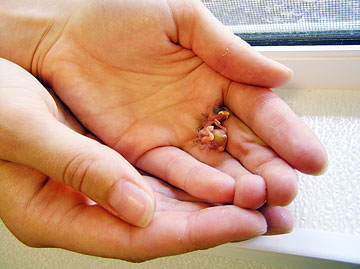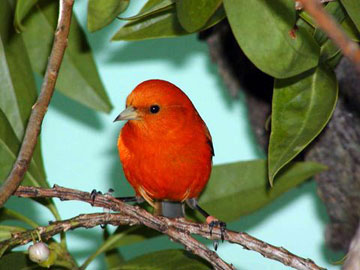 COURTESY ZOOLOGICAL SOCIETY OF SAN DIEGO This day-old 'akepa chick is believed to be the smallest bird of any species ever hatched and reared in captivity using artificial incubation and rearing techniques. CLICK FOR LARGE |
|
Tiny 'akepa hatched in San Diego is being raised by hand
This bird in hand is worth cooing over as the tiniest ever raised in captivity
STORY SUMMARY »
Fresh out of the shell, it tipped the scales at 0.94 grams, about the same as a paper clip. That makes the rare baby 'akepa the smallest songbird ever reared by hand.
With a steady diet of cricket and mealworm guts, bee larvae and pieces of hard-boiled egg, the endangered hatchling is expected to continue to bulk up at the San Diego Zoo.
Its destination: a forest oasis in the middle of a lava desert on the slopes of Mauna Kea, perhaps as early as August.
 COURTESY ZOOLOGICAL SOCIETY OF SAN DIEGO A day-old rare 'akepa chick is gently cradled at the San Diego Zoo. CLICK FOR LARGE |
|
An endangered Hawaiian 'akepa weighing no more than a pebble is "the smallest songbird ever hatched and reared by hand," says a San Diego Zoo official.
It weighed 0.94 gram, less than 1/30th of an ounce, the Hawaii Endangered Bird Conservation Program reported.
"It is absolutely without question the smallest bird ever hatched in our program," Alan Lieberman, manager of the Zoological Society of San Diego program, said yesterday by telephone.
It might even be the smallest of any species ever hatched and reared in captivity using artificial incubation and rearing techniques, but that isn't known for sure, he added.
He said the baby is "all the way up to 6 grams now" and it is nearing the age when it will fledge, or leave the nest. "It is really moving along."
In a news release announcing the addition to the 'akepa population, he said, "Hatching any chick of this size is one of the ultimate avicultural challenges we face. The feeding and temperature regulation is of critical importance, where any miscue can be disastrous."
Hourly feedings are necessary almost around the clock until the chick is about 16 days old, he said. Its diet includes a combination of bee larvae, cricket and mealworm guts and hard-boiled egg, with vitamin and mineral supplements of calcium, B1 (yeast), bone meal and tonic.
 COURTESY ZOOLOGICAL SOCIETY OF SAN DIEGO Shown here is a file photo of an adult male 'akepa. CLICK FOR LARGE |
|
 COURTESY ZOOLOGICAL SOCIETY OF SAN DIEGO Also shown here is a file photo of an adult female 'akepa. CLICK FOR LARGE |
|
Native fruits and nectar will be introduced to the chick when it's older.
Excited about the baby, Lieberman said 15 'akepa (ah-KE-pa) have been raised in the conservation program, but none in the past few years because they didn't want to breed more babies than they had space for.
Of the 15, he said 12 have survived and some will be released in August in a new management area called Kipuka 21 on Mauna Kea's slopes by Saddle Road. Kipuka in Hawaiian means "island" of land surrounded by young lava flows.
"That's another reason why it's exciting," Lieberman said. "It was everybody's last chance to raise the smallest bird we ever had."
He said the zoo will keep a few of the 'akepa to display for educational purposes.
Native Hawaiian forests are the most threatened bird habitat in the nation, according to the American Bird Conservancy.
Of 95 birds listed as threatened or endangered by the U.S. Fish and Wildlife Service, 31 are Hawaiian birds, said David Leonard, wildlife biologist with the state Department of Land and Natural Resources.
The Hawaii Endangered Bird Conservation Program began in 1993 with nonendangered species to work on rearing techniques, then progressed to critically endangered birds.
The 'akepa population probably ranges from 10,000 to 15,000, the wildlife biologists said. "It is not one of the most critically endangered," Leonard said.
The breeding and release program is a collaboration of the Zoological Society of San Diego, the Hawaii Division of Forestry and Wildlife, the U.S. Fish and Wildlife Service and U.S. Geological Survey.
Leonard noted that work is being done to Saddle Road and there is no parking space for people who might want to pull over by the Kipuka 21 site after the birds are released.
He said a parking facility is being planned that will be handicap accessible and, once it is available, signs will be posted.
"Hopefully they (birds) will stay in the kipuka," he said. "There are many forest islands in the area and most likely they will move among them."

